Brief: Linux system manufacturer System76 introduced a beautiful looking Linux distribution called Pop!_OS. But is Pop OS worth an install? Read the Pop OS review and find out yourself.
When I saw that System 76 launched their #TryPopOS campaign last month I knew this was the perfect opportunity to really put Pop!_OS through its paces. I am a proud owner of the Galago Pro, which I purchased the day they launched pre-orders this Spring and it has been my primary computer since then. I use it for everything from writing articles, to browsing the internet, to light gaming, and though the machine has its quirks I am beyond happy with it.
Back when I ordered the laptop Pop!_OS wasn’t announced yet so my laptop came with stock Ubuntu, which I promptly replaced with Ubuntu GNOME. Since then I have tried a couple different options including Elementary OS, Manjaro GNOME Edition, and most recently I have settled on KDE Neon.
Everything I have thrown at it has worked great on it so far, but now it is time to try something different. Here is my experience with System 76’s Pop!_OS.
Pop OS Review
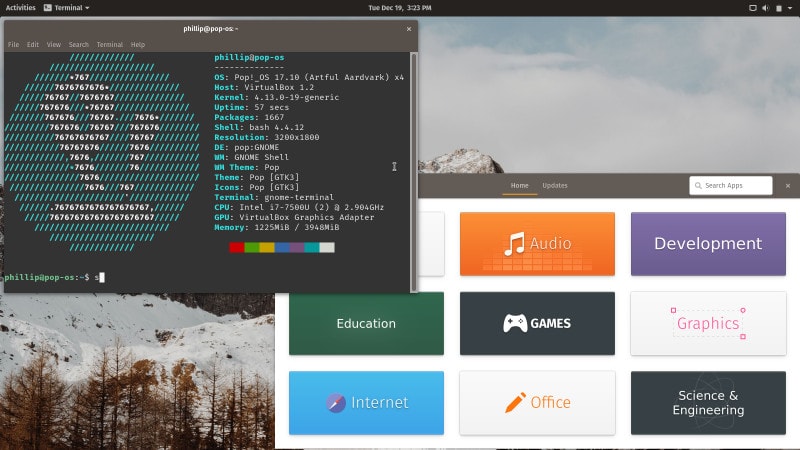
To preface, let me clarify that my Galago Pro was not the only computer I ran Pop!_OS on. First I installed it on my 2011 11 inch Acer Aspire One to see how it would do on a low spec machine.
For a mid-range experience, I ran it in a virtual machine on my Galago Pro with 2 cores, 4 GB of ram, and 128 MB of VRAM. After that, I installed it on my mid tier gaming tower. That machine has an Intel i5 processor, a Nvidia 1050 graphics card, and 16 GB of ram.
Finally, after a couple test drives, I fully installed it on my Galago Pro for about a week to see how I would like it.
To deeper understand the OS, I decided to judge it not on my personal workflow but on the quality of experience that System 76 is trying to create. That means, apart from installing Neofetch, I stayed away from the terminal for updates and application installations. I used Pop!_OS’s version of the application store, Pop Shop, for these types of things.
I also refrained from customizing the UI as much as possible. I didn’t even install GNOME Tweaks in this run, which Pop!_OS does not come preloaded with. Since Pop!_OS uses GNOME, I could have done this to install various extensions to expand my usability but decided against it for the sake of this review. I wanted the pure experience that System 76 is creating.

Background and Overview
System 76 announced Pop!_OS after Canonical decided to stop development of Unity 8. This marked the end of Canonical’s hopes of implementing convergence in Ubuntu proper and sparked the beginning of a collaborative relationship with the GNOME team.
Many people were excited about this, while others were quite disappointed, myself included. System 76 was one of those groups of people who had high hopes for Unity 8 and the future convergence had to offer. They had hung tight and stayed faithful as we all awaited the next step of Unity’s development. I don’t doubt that System 76 had thrown around the idea of creating their own OS before this happened, but I firmly believe that this announcement is what really pushed them to create what we now know as Pop!_OS.
So what is Pop!_OS? In the marketing world, the question people would ask is “what makes this different, better, special?” In short, what is the draw here? Now, I will admit, when I first heard about Pop!_OS I thought it would be just a skinned version of Ubuntu GNOME. Before they released Pop!_OS they released their own Pop OS icon pack and theme and announced the fonts they were going to use. Once I installed them I couldn’t help but think that was all Pop!_OS was going to offer. A new coat of paint on the GNOME desktop.
After some time passed, after I tested it out, and as System 76 release more and more information about their new OS I happily found that I was wrong. What is great about Pop!_OS is not what it is. At this point, it is just another distribution that honestly fragments the world of Linux just a little bit more. And I don’t necessarily mean that in a bad way.
But what makes Pop!_OS different, better, special is what it can and will be. Forgive the comparison, but System 76 is in a position to take on the role of the “Apple of the Linux world.” Not only are they making the hardware, but now they have committed to making software designed for the machines they will be on. They are in a place where they can design these two separate pieces of personal computing in tandem.
This will undoubtedly make for a more seamless and clean interaction between the two. The future of Pop!_OS is where my excitement lies, but that doesn’t mean it isn’t great now because it definitely is.
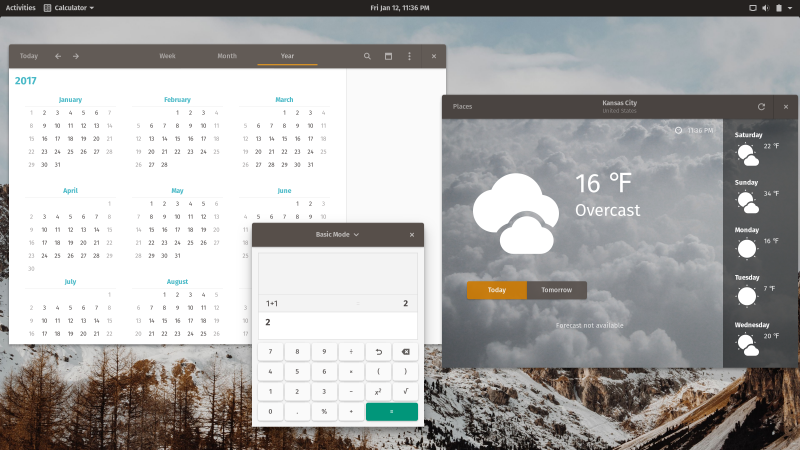
Compatibility
This is something that most distributions don’t have a huge problem with, but Pop!_OS takes it to the next level. On their site, System 76 offers two different Pop!_OS downloads: one for Intel/AMD drivers and one for Nvidia.
This is awesome! Seriously. Why is this not the norm at this point? It’s such a simple concept. The only difference here is that the Nvidia download AUTOMATICALLY downloads the Nivida drivers onto your system so your Nvidia graphics card should work right out of the box. It does not get more seamless than that. I tried both of these options and in my use case both worked perfectly.
All my machines worked great as expected, so as long as your system meets the based criteria of 2 GB of ram, 16 GB of storage, and a 64-bit processor then you should be good. The only “downside” I can find regarding compatibility is that they only support 64-bit architecture. But is that really a downside in 2018?
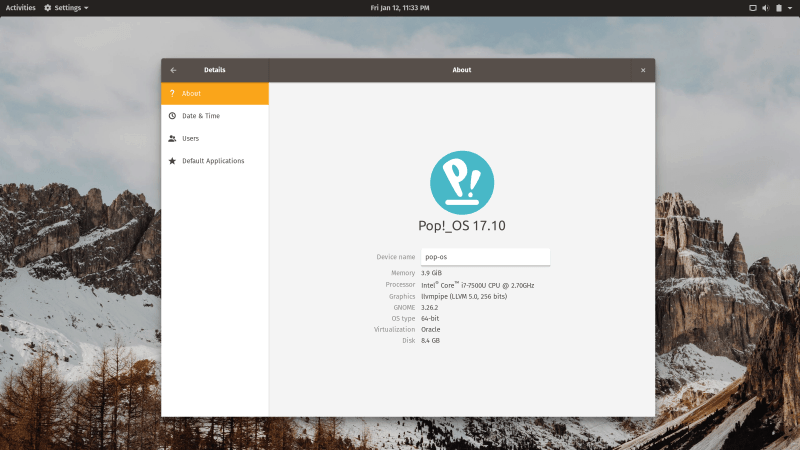
Look and Feel
Now to the fun part. Pop!_OS is easily one of the best-looking desktop environments I have ever used. I would say it is tied with Elementary OS, the Budgie desktop environment on Solus OS, Deepin, and Manjaro GNOME Edition.
That’s not to say that other distributions aren’t beautiful too or that any of these are even my favorite looking options. I am just saying that I think they are objectively some of the most beautiful options Linux has to offer. I personally prefer the default look of Plasma 5 or Unity with the Numix themes and icons installed. Plasma is simple, clean, and professional, while Unity with the Numix theme is iconic, unique, and functional.
But Pop!_OS, as well as these other options, offer a bit of flair that is on a different level. They aren’t over the top, but they are clean and modern. I think a key signifier that a distro is “objectively beautiful” is if at first glance any person, Linux user or not, were to look at said desktop and think “whoa that is really pretty!” Of which Pop!_OS is most certainly included.
Like I mentioned earlier, Pop!_OS has its own desktop GTK theme and icon pack, and uses two fonts, the Roboto Slab and Fira fonts, for its UI. Many of us are familiar with the Roboto font family, and Fira was originally developed for Firefox OS back in 2013, so both of these fonts predate the OS. Though the theme and icons are originally based on other of other projects they add enough character to consider them a new entity on their own. I would say that the icons are not as unique as the theme. They are still dangerously similar to their source icon pack, Papirus, but still, add some changes that I think make sense. The GTK theme, which is based on the Adapta Theme, looks almost nothing like it did originally. Other than the flat elements, System 76 did a great job at making the Adapta Theme their own with the Pop GTK Theme. For what it’s worth, I also think the cursor looks nice though I am not sure if this is a new or a forked project.
That being said, the entire OS has a very flat, minimal, and clean UI that makes sense in 2018. Some people are not a fan of the flat design language, but I believe the general consensus is that this is the present standard of a modern technology UI. I for one have no problem with it. I think flat design language is beautiful, to say the least. Though it became popular with the Android Lollipop update when Google introduced their Material Design language, many other companies and designers have used that concept and made it completely unique. System 76 is no exception and I am more than satisfied with the theme they have created.
System 76 has also created their own installer experience in Pop!_OS. The installation process is kin to one of an OEM installation. That makes sense since this will be the primary option System 76 will include on their computers moving forward. This means the first person to log in after you install the OS will be prompted to set up their user account as if they turned on the laptop for the first time. This is a nice touch that adds no real confusion or fuss to the Ubuntu installation process we are already used to.
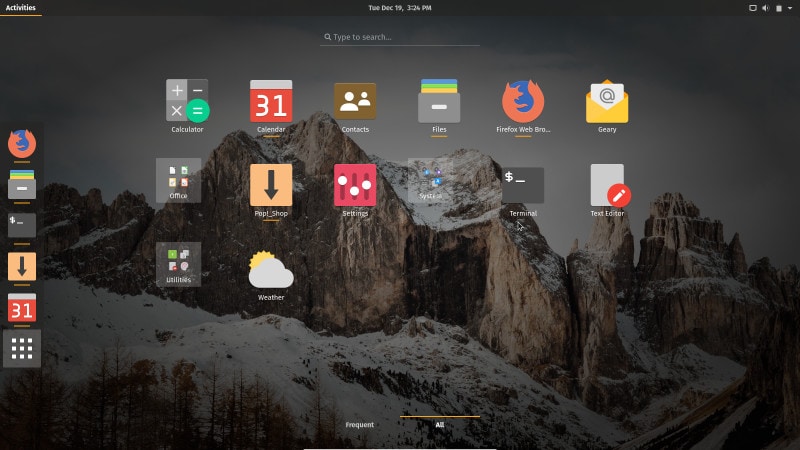
Performance and Work Flow
As far as functionality is concerned, if you are used to default GNOME then you will feel at home in Pop!_OS. The DE tries the best it can to get out of the way of your work. There is no dock, no activities bar that shows your open applications immediately on the desktop, and the system tray is very minimal by default. As per GNOME, the Activities Overview is where all of that information will pop into view, no pun intended. With a press of the super key, you will see all of your open applications laid out in a grid, the GNOME dash which is pretty much an on command dock, and all your virtual desktops.
None of this is new. This is the standard GNOME way of doing things. The difference is that Pop!_OS just looks so much more beautiful while doing so. It maintains the same smooth and quick interface, and the animations are simple. They just enough to add a feeling of quality to your desktop environment not their previously. But there is one glaring downside, in my opinion.
For a lot of us who are used to a more traditional desktop environment Pop!_OS may be a little harder to navigate at first with the omission of the minimize and maximize window buttons. It keeps the close button, but all three of these buttons are so integral to my experience that it was quite difficult to get used to not using them.
This is the same critique I have of Elementary OS. If I were to use Pop!_OS as a full-time DE I would install GNOME Tweak Tool if only to add these buttons back. Now, I said I would rate the OS based off of what System 76 was trying to achieve and not based on my personal workflow, which I am. But I genuinely think that adding this functionality by default is simply a better way of doing things, though I respect System 76’s decision not to do so.
The performance of the OS is as you would expect. I was not able to see a consistent difference between default Ubuntu GNOME and Pop!_OS. They used about the same amount of system resources at boot up, game performance was almost identical, and any form of video and image editing I did with it worked just as expected. So really there is nothing that stands out here in Pop!_OS. But that is a good thing. In fact, that’s a great thing. The OS was smooth, functional, and melted into the background just as it was intended to.
Pop!_OS gets a perfect score in the performance category.
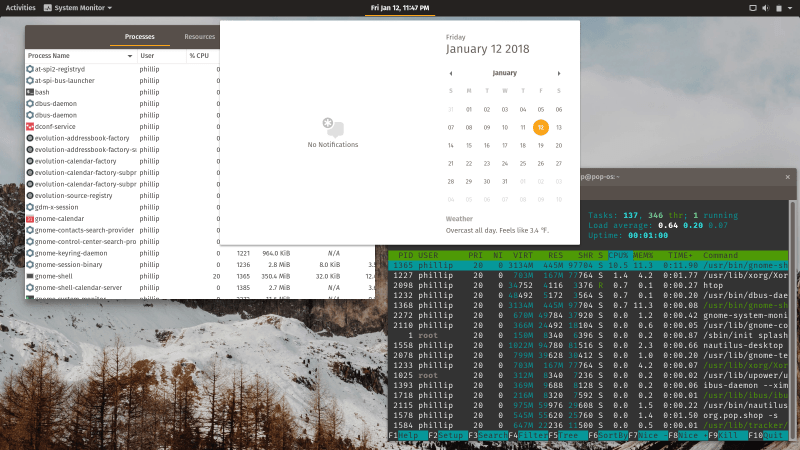
Conclusion
So all of that is fine and great, but what is my overall opinion of System 76’s distribution? Before I answer that, I think the final question is who is Pop!_OS for? I have intentionally avoided asking this question up until this point, and I have done so for one main reason: I don’t think it matters.
Now, System 76 says directly on their site that this is a distribution for scientists, engineers, creators, makers, etc. It is designed for people who need to get things done on a technical level. The reason I say that this is that though we know who System 76’s target market is I see no reason why this distro can’t be for someone else.
In fact, I think a better question than asking “who is Pop!_OS for?” is “who is it NOT for?” That is a simpler question in my opinion because that demographic is much smaller. Pop!_OS is not for a person who either considers themselves a Linux power user, someone who is used to traditional desktop paradigms with no interest in changing that, and/or someone who just simply doesn’t like the style of Pop!_OS.
I say this may not be for a Linux power user because we are a very picky sort of bunch. Yes, I include myself in this group, so I am admitting Pop!_OS may not be for me. I know how I can get things done. I know the best workflow for my computing experience. And honestly, that is not with something like Pop!_OS. I may not be what I call a true power user like some spec happy gamers, various software engineers, or even as video game developers, but I know what I am used to and how I can get things done effectively.
Not to say I couldn’t achieve that with Pop!_OS with a few tweaks here and there. It can be made to do whatever you want because, in the end, it is still Linux. I just believe customizing it too much sort of takes away from the point of choosing something like this. Why commit to Pop!_OS to simply make it something else?
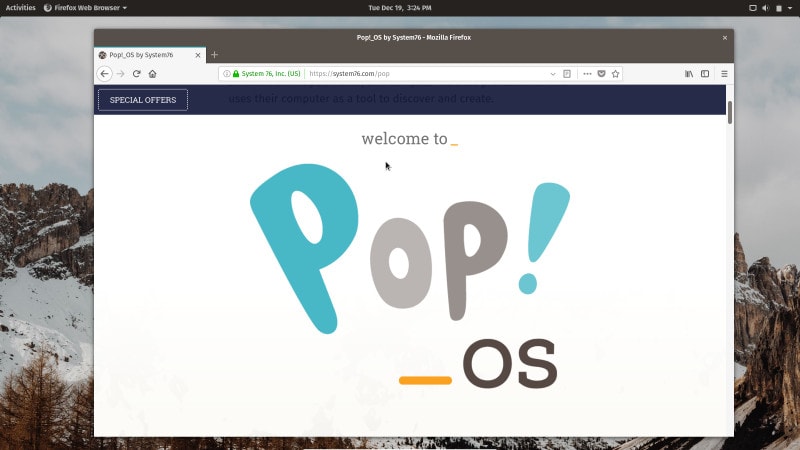
Overall, I think Pop!_OS is a fantastic distribution that most people could really enjoy if they opened up their workflow to something they may or may not be used to. It is clean, fast, and well developed. Which I think is exactly what System 76 was going for here.
This was not an exhaustive review by any means, but I hope you have a better idea as to what this option has to offer the Linux community as a whole. As I stated earlier, what excites me most about Pop!_OS is not what it is, but what it can be. The future of System 76’s distribution is bright, and I am excited to see where they take it moving forward.
Let me know what you think about Pop!_OS. Are you as optimistic about it as I am or do you think this was a pointless endeavor as others seem to think? Let me know either way in the comment section below, as well as any other information you think I missed in this review.


